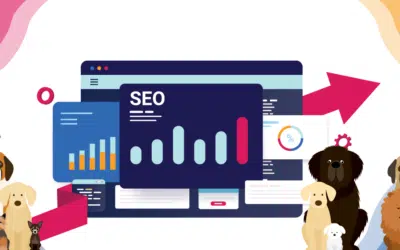For many companies across a variety of industries, a website is often the first impression potential customers have of their business. Yet, surprisingly, many companies—large and small—allow their online presence to stagnate, with content that hasn’t been updated in months, or even years. This can have a significant impact on your brand’s credibility and SEO performance. Refreshing website content regularly is not just a good practice; it’s essential to keeping your audience engaged, improving search engine rankings, and staying ahead of the competition. In this blog, we’ll explore why timely updates are crucial for your business’s success and how neglecting this can cost you more than just visibility.
The Situation for Many Companies – A Missed Opportunity
Many companies treat their websites as static brochures, designed to showcase products and services, but rarely updated once launched. This approach often stems from the belief that once a website is live, it’s “finished.” The mindset is understandable—after all, the purpose of the site is to inform potential customers about what the company offers. However, this can lead to a significant missed opportunity.
When a website simply lists products and services, it fulfills a basic function but falls short of engaging visitors on a deeper level. Such a site quickly becomes outdated, both in terms of content and user experience. Visitors who return to the site might find the same information, presented in the same way, which can give the impression that the company is stagnant or uninterested in evolving to meet changing customer needs.
Additionally, one of the key benefits of consistently refreshing website content is the ability to leverage analytics data effectively. By monitoring user behavior on a regularly updated site, businesses can gain valuable insights into what content resonates with their audience, which pages attract the most traffic, and what actions visitors are taking. This data is crucial for refining marketing strategies, improving user experience, and ultimately driving leads and conversions.
Additionally, updating a website consistently allows companies to experiment with new hooks and selling points, tailoring their messaging to better connect with potential customers. For instance, introducing fresh calls-to-action, new product features, or limited-time offers can capture the attention of both new and returning visitors. This approach not only keeps the website dynamic and engaging but also provides a platform for testing what messaging and content types are most effective in generating leads and maintaining visitor interest. Companies that remain static miss out on these critical learning opportunities, which can hinder their ability to adapt to market trends and improve their competitive edge. Simply put, the ability to test, learn, and iterate is key to sustained online success.
Lastly, When a company fails to update and refresh its website, the impact on search engine optimization (SEO) can be significantly negative. Search engines, like Google, prioritize websites that are active and consistently offer fresh, relevant content. Regularly updated content signals to search engines that a website is current, authoritative, and valuable to users. When a website remains stagnant for extended periods, search engines may interpret it as outdated or less relevant, causing the site’s rankings to drop in search results.
Additionally, SEO best practices are continually evolving. What worked a year ago may no longer be effective, and without updates, a website may fall behind in critical areas like keyword optimization, meta descriptions, and mobile responsiveness. Furthermore, new content opportunities such as blog posts, case studies, or customer testimonials not only provide fresh material for search engines to index but also allow for targeting new keywords and reaching different segments of the audience. Without these updates, a website can lose visibility, driving less organic traffic and making it harder for potential customers to find the business online. In the competitive digital landscape, failing to maintain and optimize your website regularly can result in lost opportunities, reduced traffic, and ultimately, diminished business growth.
Content Ideas
Now that we’re in agreement that updated content is important for your website and business to thrive, let’s examine some of the ways marketing and communication professionals can implement refreshed content.
Blogging – An Opportunity to Expand Your Reach Beyond Just Your Products and Services
For many reasons, adding a blog is the easiest and most obvious way to add content to your website, but it’s important to do it correctly.
Adding a blog and subsequent posts can be one of the most impactful strategies for driving engagement, expanding your reach, and boosting your SEO efforts. A blog serves as a platform to share interesting, valuable content that keeps users coming back to your site. Whether you’re offering industry insights, how-to guides, or thought leadership pieces, a blog gives your audience a reason to return regularly. This consistent stream of fresh content not only helps build a loyal following but also positions your brand as an authority in your field, fostering trust and credibility with your audience.
Beyond engaging your audience, a blog is a powerful tool for content marketing across other channels. Each blog post can be repurposed into social media content, email marketing newsletters, and other promotional materials. For example, a well-crafted blog post can be summarized into a series of social media posts, driving traffic back to your website on the platforms your customers use most often. It can also provide the core content for an email newsletter, keeping your subscribers informed and engaged with valuable insights or updates. Both email and social media serve as important marketing channels, because not only are they effective, but in most cases they are free. Other than time, there is often no significant cost to using these marketing channels and blogs provide the fuel for consistent content. By consistently generating new content, your blog becomes the engine that drives your broader marketing efforts, ensuring that your brand remains active and visible across multiple platforms.
From an SEO perspective, a blog offers significant opportunities to capture search traffic for a wide range of topics and keywords. While your main website pages might target specific product or service-related content and keywords, blog posts allow you to explore adjacent topics that are relevant to your audience that would not normally be a part of your business’s website. This can include answering common customer questions, discussing industry trends, or providing educational content that resonates with your target market. For example, let’s say you’re a nurse staffing agency that connects travel nurses with healthcare facilities in need of filling those positions. While your main website might list your core values, mission state and services, a relevant blog for example might be titled, “Best States for Travel Nurses.” An engaging blog on this topic allows you to win traffic that weren’t necessarily looking for your products and services. By covering these topics, your website can rank for a variety of long-tail keywords, increasing the chances of appearing in search results for users seeking related information. This not only drives more organic traffic to your site but also attracts potential customers at different stages of the buying journey.
Furthermore, each blog post is a chance to incorporate internal and external links, which are crucial for SEO. Internal links help guide visitors to other relevant pages on your site, increasing the time they spend on your website and improving your site’s overall structure. External links to authoritative sources enhance your content’s credibility and can also encourage backlinks, which are a key factor in search engine rankings. By regularly publishing high-quality blog posts, you’re creating a cycle of content that not only engages users but also continually strengthens your website’s SEO performance. In the long run, this can lead to higher search rankings, more traffic, and ultimately, more leads and conversions for your business.
Case Studies – Showcase Your Success Stories
Incorporating case studies into your website is a highly effective content strategy that can benefit businesses across a wide range of industries. Case studies allow you to showcase real-world examples of how your products or services have solved specific problems for your clients, demonstrating the tangible value your company delivers. Unlike generic marketing content, case studies offer concrete evidence of your expertise and effectiveness, making them particularly compelling for potential customers who are in the decision-making phase of their buying journey. By illustrating successful outcomes, case studies help build trust and credibility, showing that your business can deliver on its promises.
Case studies are also highly versatile content assets that can be used in various marketing efforts. For instance, they can be featured on your website as standalone pages, included in blog posts, or shared through email campaigns and social media channels. They offer a narrative-driven approach to content, making them more engaging than traditional product descriptions or service listings. By highlighting specific challenges faced by clients and the tailored solutions your business provides, case studies allow potential customers to see themselves in the story, envisioning how your offerings can meet their own needs. This personal connection can be a powerful motivator in converting leads into loyal customers.
Furthermore, case studies are particularly valuable in industries where the sales cycle is longer or more complex, such as B2B services, healthcare, technology, and finance. In these sectors, decision-makers often require detailed information and reassurance before committing to a purchase. Case studies provide that depth, offering a comprehensive look at the process, strategy, and results that went into solving a particular problem. This level of detail can help to alleviate concerns, address objections, and ultimately, guide prospects toward making an informed decision in favor of your business.
In addition to their role in lead generation and conversion, case studies can also contribute positively to your SEO efforts. Each case study page represents a fresh piece of content that can be optimized for search engines, targeting specific keywords related to the challenges and solutions featured in the case.
Reviews – Let Your Best Customers Sing Your Praises
Adding customer reviews to your website is an essential strategy for building trust, enhancing credibility, and influencing potential buyers’ decisions. Today more than ever, consumers rely heavily on the experiences and opinions of others before making a purchase. Reviews provide social proof, showing that real customers have used your products or services and had positive experiences. This third-party validation can significantly boost a potential customer’s confidence in your business, making them more likely to convert from a casual visitor to a paying customer.
Moreover, reviews can also improve your website’s SEO performance. Search engines like Google consider customer reviews as a form of fresh, user-generated content, which can positively impact your site’s visibility in search results. Reviews that include specific product names or keywords can help your website rank for those terms, attracting more organic traffic. Additionally, having a high volume of positive reviews can enhance your business’s local SEO, making it easier for nearby customers to find you when searching for products or services in your area.
Lead Magnets – Capture Potential Customers’ Information
Adding lead magnets to your website is a powerful marketing strategy that can significantly boost lead generation and help grow your email list. Lead magnets are valuable pieces of content or resources offered to visitors in exchange for their contact information, typically their email address. This strategy is highly effective because it provides a clear incentive for potential customers to engage with your brand, turning casual visitors into qualified leads who are interested in what your business has to offer. By offering something of value upfront, you establish a relationship based on trust and reciprocity, making it more likely that these leads will convert into paying customers down the line.
Effective lead magnets are those that are closely aligned with the needs and interests of your target audience. For example, a B2B software company might offer a free eBook or whitepaper that provides in-depth insights into industry trends or best practices, positioning the company as a thought leader while gathering valuable contact information. A retail brand might provide a discount code or a free shipping offer in exchange for an email sign-up, enticing visitors to make a purchase while building their email list for future marketing efforts. Other popular lead magnets include free trials, webinars, checklists, templates, and case studies—each designed to provide immediate value while nudging the prospect further along the buyer’s journey.
The key to successful lead magnets is to ensure they are relevant, high-quality, and solve a specific problem or fulfill a need for your audience. When done right, lead magnets not only increase the number of leads you capture but also improve the quality of those leads by attracting individuals who are genuinely interested in your products or services. This targeted approach to lead generation can lead to higher conversion rates, as you’re engaging with prospects who have already shown an interest in what you have to offer. Ultimately, lead magnets help you build a more engaged and responsive audience, which is crucial for long-term business growth and success.
Of course no lead magnet strategy is complete without the strategies to communicate with your newly minted leads. Email marketing, drip campaigns and sales collateral will help move your leads through the funnel to ultimately become customers.
Better Operational Tools
Improving your website’s functionality can have a transformative impact on your business, offering enhanced user experiences that drive engagement, streamline operations, and increase customer satisfaction. By integrating advanced tools and features that cater specifically to the needs of your audience, you not only make it easier for users to interact with your business but also position your brand as a leader in customer service and innovation. For instance, healthcare providers who add appointment booking functionality to their websites can offer patients the convenience of scheduling visits online vs a general contact form, reducing administrative burden and improving patient satisfaction. This kind of functionality not only meets modern consumer expectations but also fosters loyalty by making essential services more accessible.
Similarly, businesses like staffing agencies can benefit greatly from adding specialized functionalities such as job portals to their websites. A well-designed job portal allows candidates to easily search for open positions, submit applications, and track their application status, all in one place. This not only enhances the candidate experience but also streamlines the recruitment process, making it more efficient and effective. For the business, it means attracting a larger pool of qualified candidates while reducing the time and resources spent on manual processes.
Other functional improvements, such as direct meeting schedulers, account areas, and informational database tools, further enhance the utility of your website. Meeting schedulers, for example, allow B2B clients the opportunity to book consultations or meetings immediately at their convenience, eliminating the back-and-forth often associated with setting sales calls. Account / login areas give customers a personalized space where they can manage their interactions with your business, view their history, and access exclusive content. Informational database tools provide users with quick access to valuable resources, such as product guides, FAQs, or industry reports, making your website a go-to source for reliable information. Each of these functionalities not only improves the user experience but also streamlines operations and opens up new opportunities for engagement, ultimately contributing to stronger customer relationships and sustained business growth.
Improved Product and Services Pages
Refreshing core product and service pages is crucial for maintaining a dynamic and effective online presence. These pages are often the primary source of information for potential customers seeking to understand what your business offers, making them integral to your website’s overall effectiveness. Regular updates to these pages ensure that they reflect the latest developments in your products or services, incorporate new features, and align with current market trends. This not only keeps your content relevant but also enhances the credibility of your business by demonstrating that you are actively engaged in offering the best solutions to your customers.
Incorporating a variety of engaging elements—such as high-quality images, videos, and infographics—can significantly enhance the appeal and functionality of product and service pages. Visual content helps break down complex information, making it easier for visitors to understand and connect with what you’re offering. For instance, detailed product images or instructional videos can showcase features and benefits more effectively than text alone, helping potential customers visualize how the product or service will meet their needs. Infographics can distill key information into an easily digestible format, making it more likely that visitors will retain and act on the information presented.
Furthermore, regularly updating these pages provides an opportunity to showcase new case studies, testimonials, or success stories that illustrate the real-world impact of your products or services. This not only adds fresh content but also reinforces your brand’s value proposition through real examples. By continuously improving and refining your product and service pages, you can better address changing customer needs, highlight new offerings, and optimize the user experience. This ongoing process helps ensure that your website remains a relevant and compelling resource, effectively converting visitors into leads and ultimately driving business growth.
Conclusion
Keeping your website’s content fresh and relevant is more important than ever for maintaining a competitive edge. Outdated information can hinder your online presence and affect your ability to connect with and convert potential customers. But let’s face it. Who has time to think about this when you’re busy running your operations. At Conway Marketing Group, we understand the challenges businesses face in keeping their websites updated and engaging. Our team is dedicated to helping companies across various industries evaluate their current content, implement strategic improvements, and add valuable resources that resonate with their target audience. Whether you need a complete website overhaul, fresh content, or targeted updates, we’re here to guide you every step of the way. Reach out to us to ensure your website not only meets but exceeds the expectations of your audience, driving growth and success for your business.



